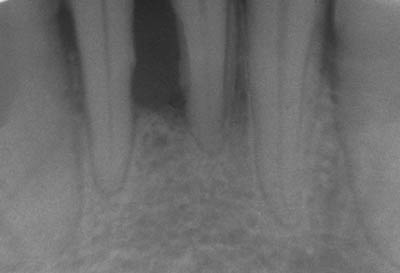|
|
| Line 9: |
Line 9: |
| }} | | }} |
|
| |
|
|
| |
| == Assessment and prognosis ==
| |
| Dentists or dental hygienists "measure" periodontal disease using a device called a [[periodontal probe]]. This is a thin "measuring stick" that is gently placed into the space between the gums and the teeth, and slipped below the gum-line. If the probe can slip more than 3 millimetres length below the gum-line, the patient is said to have a "gingival pocket" around that tooth. This is somewhat of a misnomer, as any depth is in essence a pocket, which in turn is defined by its depth, i.e., a 2 mm pocket or a 6 mm pocket. However, it is generally accepted that pockets are self-cleansable (at home, by the patient, with a toothbrush) if they are 3 mm or less in depth. This is important because if there is a pocket which is deeper than 3 mm around the tooth, at-home care will not be sufficient to cleanse the pocket, and professional care should be sought. When the pocket depths reach 5, 6 and 7 mm in depth, even the hand instruments and cavitrons used by the dental professionals cannot reach deeply enough into the pocket to clean out the bacterial plaque that cause gingival inflammation. In such a situation the pocket or the gums around that tooth will always have inflammation which will likely result in bone loss around that tooth. The only way to stop the inflammation would be for the patient to undergo some form of gingival surgery to access the depths of the pockets and perhaps even change the pocket depths so that they become 3 or less mm in depth and can once again be properly cleaned by the patient at home with his or her toothbrush.
| |
|
| |
| If a patient has 5 mm or deeper pockets around their teeth, then they would risk eventual tooth loss over the years. If this periodontal condition is not identified and the patient remains unaware of the progressive nature of the disease then, years later, they may be surprised that some teeth will gradually become loose and may need to be extracted, sometimes due to a severe infection or even pain.
| |
|
| |
| According to the Sri Lankan Tea Labourer study, in the absence of any oral hygiene activity, approximately 10% will suffer from severe periodontal disease with rapid loss of attachment (>2 mm/year). 80% will suffer from moderate loss (1-2 mm/year) and the remaining 10% will not suffer any loss.<!--
| |
| --><ref name="JclinPeriodontol1995-Preus">{{cite journal | author=Preus HR, Anerud A, Boysen H, Dunford RG, Zambon JJ, Loe H | title=The natural history of periodontal disease. The correlation of selected microbiological parameters with disease severity in Sri Lankan tea workers | journal=J Clin Periodontol | year=1995 | pages=674-8 | volume=22 | issue=9 | id=PMID 7593696}}</ref><!--
| |
| --><ref name="ComDentOralEpidemiol1984-Ekanayaka">{{cite journal | author=Ekanayaka A | title=Tooth mortality in plantation workers and residents in Sri Lanka | journal=Community Dent Oral Epidemiol | year=1984 | pages=128-35 | volume=12 | issue=2 | id=PMID 6584263}}</ref>
| |
|
| |
|
| ==Related Chapters== | | ==Related Chapters== |
